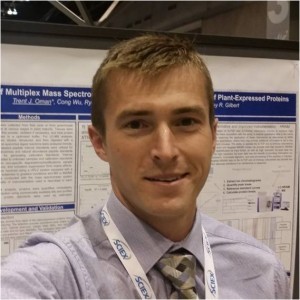2016 New Investigator: Trent Oman

Nominee:
Nominated By:
Supporting Comments:
What made you choose a career in bioanalysis?
I have experienced first-hand how research and technology have improved human health. As a child, I was diagnosed with insulin-dependent diabetes, which presented many challenges and questions. I recall curiously asking my parents, “How does insulin work? How does a glucometer measure blood glucose?” My questions and desire to better understand diabetes served as a catalyst to pursue a career in science. Today my research is reliant on bioanalytical techniques, especially mass spectrometry, to address many complex biological problems. It has been rewarding to grow with and contribute to advancements in the bioanalysis field and to the community of practitioners.
Describe the main highlights of your bioanalytical research, and its importance to the bioanalytical community.
The main highlights of my research fall at the crossroads of qualitative/quantitative analytical chemistry and biochemistry. As a graduate student, I studied classes of peptide-based natural products that are first ribosomally synthesized as simple precursors and then post-translationally modified into structurally complex bioactive forms. Understanding the mechanisms by which the biochemical transformations occur as well as elucidation of the structures and modifications of the final products is both analytically challenging and exciting in a relatively under explored area of research. I have demonstrated in many key publications, how one can systematically investigate both the biosynthesis and post-translational modifications of several classes of natural products. I developed multiple sample preparation protocols, reactions, and techniques in my studies that have been leveraged across this area of natural products research and the bioanalytical community. As an industry researcher in the agriculture biotechnology field, I have focused on the challenging areas of plant proteomics and metabolomics. For proteomics analyses, I have developed protein/peptide structural interrogation workflows for monitoring PTMs and in vivo processing, and have further expanded my impact by developing mass spectrometry-based strategies for quantitation of plant-expressed proteins. My team established the industry standard for this technology and is actively utilizing it for product development.
What is the impact of your work beyond your home laboratory?
My most impactful work to the bioanalysis field has been my recent works focused on mass spectrometry-based platforms for protein quantitation in plants. To date, the measurement of protein levels in crops has been achieved almost exclusively by immunoassay; however, immunoassays rely upon the use of antibodies that are highly specific and sensitive to the protein of interest, but may not be readily available in the early stages of the discovery process. In addition, many of the latest crops provide multiple modes of protection to the plant through ‘stacked traits’, resulting in the simultaneous expression of several transgenic proteins. To overcome this challenge, I successfully developed several multiplexed LC-MS/MS workflows to accurately and precisely quantify several plant-expressed proteins in a single analysis. These workflows have gained significant traction throughout our product development process and are currently being licensed and adopted by competitors and other companies across the agriculture biotechnology industry.
Describe the most difficult challenge you have encountered in the laboratory and how you overcame it.
In graduate school, I was investigating the structure of the Bacillus-produced antimicrobial peptide, sublancin, which was previously reported to contain a number of PTMs characteristic of lantibiotic natural products. I had discovered through carefully designed peptide mass fingerprinting experiments and MS/MS sequencing of sample-limited, culture-isolated sample of sublancin, that the compound was not marked by the previously reported PTMs, but rather a +162 Da modification on a cysteine residue. Surprised, I searched the literature to find that a modification of this mass suggested glycosylation of a hexose sugar. However, no examples of a hexose sugar conjugation to cysteine had been reported. Classical approaches to study and identify protein glycosylation utilize specific glycosidase enzymes to liberate O– and N-linked conjugated sugars; however, I found that S-linked conjugation is remarkably stable and no enzymatic removal and identification was possible. I relentlessly explored numerous non-specific chemical routes of sugar cleavage and was finally able to release and identify the bound sugar by derivatization followed by GC-MS analysis and comparison to hexose sugar standards. To confirm our results, we utilized 2D and 3D NMR experiments, confirmed the sugar identity, and ultimately re-assigned the structure as the first reported S-linked glycopeptide from bacteria.
Describe your role in bioanalytical communities/groups.
I have found throughout my career that sharing research and results is the catalyst for advancing science, encouraging collaborations, and sparking new ideas. I make it a priority to publish articles each year that introduce a novel or improved technology that benefits not only researchers in that particular field, but also others throughout the bioanalytical community. I have presented numerous oral presentations, posters, and served as a discussion panelist and steering team member at venues such as ACS National Meetings, ASMS Annual Conferences, and the agriculture biotechnology focused, Analytical Excellence through Industry Collaboration (AEIC) Conference. I am an active member of AEIC, where I help to establish analytical tools for agriculture, environmental, and biotechnology applications and work alongside corporate and government agencies to ensure the best bioanalytical practices across the food and feed industry. In my current organization and during my graduate school tenure, I regularly host hands-on bioanalytical training sessions that introduce scientists and graduate students to various sample preparation techniques and analytical instrumentation such as chromatography and mass spectrometry instruments to enable the success of their research efforts. I have also co-developed and annually deliver a mass spectrometry short course to the R&D organization within my current company.
Please list up to five of your publications in the field of bioanalysis:
- T. J. Oman, J. M. Boettcher, H. Wang, X. N. Okalibe, W. A. van der Donk. Sublancin is not a lantibiotic but an S-linked glycopeptide. Nature Chemical Biology, 7, 78-80 (2011).
- T. J. Oman, P. J. Knerr, N. A. Bindman, J. E. Velásquez, W. A. van der Donk. An engineered lantibiotic synthetase that does not require a leader peptide on its substrate. Journal of the American Chemical Society, 134, 6952-6955 (2012).
- R. C. Hill, T. J. Oman, G. Shan, B. Schafer, J. Eble, C. Chen. Development and Validation of a Multiplexed Protein Quantitation Assay for the Determination of Three Recombinant Proteins in Soybean Tissues by Liquid Chromatography with Tandem Mass Spectrometry (LC-MS/MS). Journal of Agriculture and Food Chemistry, 63, 7450-7461 (2015).
- T. J. Oman, T. J. Lupoli, T. S. Wang, D. Kahne, S. Walker, W. A. van der Donk. Haloduracin α binds the peptidoglycan precursor lipid II with 2:1 stoichiometry. Journal of the American Chemical Society, 133, 17544-17547 (2011).
- S. L. Griffin, J. A. Godbey, T. J. Oman, S. K. Embrey, A. Karnoup, K. Kuppannan, B. W. Barnett, G. Lin, N. V. Harpham, A. N. Juba, B. W. Schafer, R. M. Cicchillo. Characterization of Aryloxyalkanoate Dioxygenase-12 (AAD-12), a Non-Heme Fe(II)/α-Ketoglutarate-Dependent Dioxygenase Expressed in Transgenic Soybean and Pseudomonas fluorescens. Journal of Agriculture and Food Chemistry, 27, 6589–6596 (2013).
Please select one publication from above that best highlights your career to date in the field of bioanalysis and provide an explanation for your choice.
Publication #1 listed above demonstrates how several bioanalytical avenues were explored in order to address many key questions of my research. It also exemplifies the power of interdisciplinary collaborations. This paper highlights the very unique natural product, sublancin. For decades, this compound was reported as a member of the lantibiotic class of antimicrobial peptides – however, this was never empirically determined. Years later, we confidently revised its structure by stitching multiple key pieces of corroborative evidence together from numerous disciplines and bioanalytical approaches. Importantly the story came together and an unprecedented bacteria post-translational modification (S-linked glycosylation) was discovered.
Find out more about this year’s New Investigator Award, the prize, the judging panel and the rest of our nominees.

